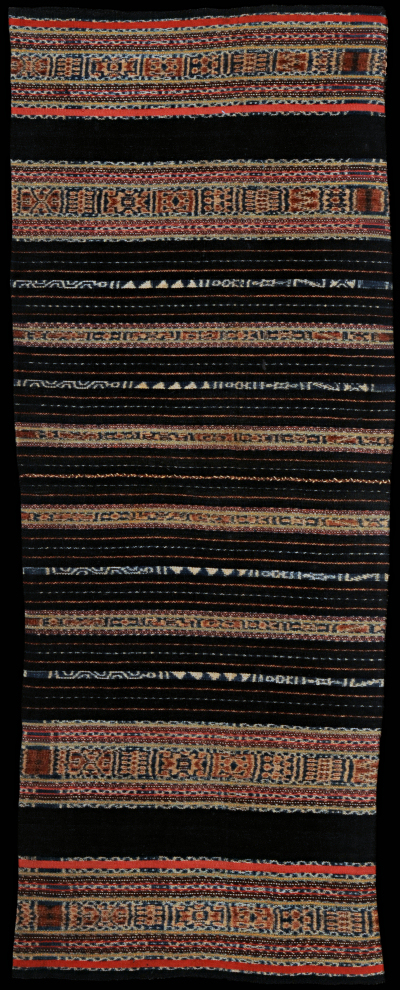| |
 
 | | | |
077 Timor, East Timor
Tais (sarong)  
| | Locale: | Lospalos, Lautem district, possibly Loré. Fataluku people. | | Period: | Early 20th c. | | Yarn: | Cotton, hand-spun, medium | | Technique: | Warp ikat | | Panels: | 2 | | Size: | 49 x 119.5 cm (1' 7" x 3' 11") LW: 2.44 | | Weight: | 525 g (18.5 oz), 448 g/m2 (1.47 oz/ft2) | | Design: | Cloth of the type sika lau, with designs insprired by the rock drawings of Ili Kere Kere. Narrow bands with figures in white on indigo representing double-headed people and double tall house roofs. Eight wider bands with flower-like medallions in red and yellow on indigo. Four stripes in brick red. Overall impression indigo with decoration in many colours. The white snaking motif may locally be called 'worm' to disguise its actual reference to a mythical lake-dwelling giant snake. | | Comment: | Beautiful and characteristic example East-Timorese Los Palos style ikat, here called futus. Tight weaving. The tapering is not a photographic distortion, but actual, and not uncommon on Timor in general. These cloths are very expensive in the region of origin, costing several heads of buffalo. All thread is hand spun, except the brick red pinstripes which were done in double-ply commercial thread, probably pre-dyed. All other colours were made with vegetable dyes with a beautiful pastel tonality. | | Background: | Chapters on Timor and East Timor. | | Exhibited: | Museu do Oriente, Lisbon, 2014/15.
Timor: Totems and Tokens, Museu do Oriente, Lisbon, 2019/20. | | Published: | Woven Languages, 2014.
Ikat Textiles of the Indonesian Archipelago, 2018. | | Compare: | 121 122 | | Sources: | Similar to sarong in Khan Majlis, Woven Messages, Fig. 308. Very few comparable pieces known. As Khan Majlis wrote in 1991: 'Textiles from this region [..] have never been published to date.' Similar to sarong in Art Institute of Chicago, acquired in 2002, No. 2002.998, part of the Bakwin collection, described in The Art of Indonesian Textiles, The E.M. Bakwin Collection, Fig 53; and to one in National Gallery of Australia, No. NGA 1992.749. Also similar to Pusaka Collection No. 122. | | |

©Peter ten Hoopen, 2025
All rights reserved.
|
|


